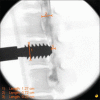Experimental study on pressure response to graded spinal canal compromise in an in vitro burst fracture mode
- PMID: 28694593
- PMCID: PMC5490343
- DOI: 10.4103/jcvjs.JCVJS_25_17
Experimental study on pressure response to graded spinal canal compromise in an in vitro burst fracture mode
Abstract
Background: Spinal cord compression is a known cause of spinal cord injury. The purpose of this study is to measure pressure response during graded spinal cord compression. This information will be important in evaluating the amount of canal compromise that can be tolerated before risking neurological injury secondary to cord compression. To date, there is no published study that has evaluated pressure response to graded canal compromise in the thoracic and lumbar spine.
Materials and methods: A comparative biomechanical investigation using an in vitro burst fracture model of graded spinal canal compromise was performed. Four porcine spines, sectioned into four thoracics and four lumbar segments, were harvested from 30 kg pigs. Graded spinal canal compromise (0.75 mm/30 s) was achieved using a modified 12.7 mm dynamic hip screw. The real-time ventral epidural pressure was measured at each 0.75 mm of canal compromise.
Results: A significant increase in spinal cord pressure was recorded during graded spinal cord compression (P < 0.0001), and there were no statistical differences between the increase in pressure measured in the thoracic and lumbar spinal segments (P = 0.83). The pressure to degree of canal compromise curve exhibited an initial rapid rise in pressure followed by incrementally smaller increases in pressure as canal compromise increased.
Conclusions: Spinal cord pressure increased with any degree of canal compromise, the most important rise occurring with initial compression. Future studies will evaluate the usefulness of laminectomy in vivo to completely restore ventral epidural pressure in the thoracic and lumbar spine.
Keywords: Graded spinal cord pressure; lumbar spine; pig model; spinal canal compromise; thoracic spine.
Conflict of interest statement
There are no conflicts of interest.
Figures



Similar articles
-
Cervical ventral epidural pressure response to graded spinal canal compromise and spinal motion.Spine (Phila Pa 1976). 2004 Jul 15;29(14):1524-9. doi: 10.1097/01.brs.0000131442.87202.39. Spine (Phila Pa 1976). 2004. PMID: 15247573
-
A thoracic and lumbar spine injury severity classification based on neurologic function grade, spinal canal deformity, and spinal biomechanical stability.Spine J. 2006 Nov-Dec;6(6):636-47. doi: 10.1016/j.spinee.2006.03.010. Epub 2006 Oct 10. Spine J. 2006. PMID: 17088194
-
A dynamic study of thoracolumbar burst fractures.J Bone Joint Surg Am. 2003 Nov;85(11):2184-9. doi: 10.2106/00004623-200311000-00020. J Bone Joint Surg Am. 2003. PMID: 14630851
-
Spinal trauma. Pathophysiology and management of traumatic spinal injuries.Vet Clin North Am Small Anim Pract. 1992 Jul;22(4):859-88. doi: 10.1016/s0195-5616(92)50080-8. Vet Clin North Am Small Anim Pract. 1992. PMID: 1641921 Review.
-
[Dorsal stabilization of fractures of the thoracic and lumbar spine by external fixator--technique and outcome].Zentralbl Chir. 1998;123(8):936-43. Zentralbl Chir. 1998. PMID: 9757539 Review. German.
References
-
- Tator CH, Fehlings MG. Review of the secondary injury theory of acute spinal cord trauma with emphasis on vascular mechanisms. J Neurosurg. 1991;75:15–26. - PubMed
-
- Anderson TE, Stokes BT. Experimental models for spinal cord injury research: Physical and physiological considerations. J Neurotrauma. 1992;9(Suppl 1):S135–42. - PubMed
-
- Amar AP, Levy ML. Pathogenesis and pharmacological strategies for mitigating secondary damage in acute spinal cord injury. Neurosurgery. 1999;44:1027–39. - PubMed
-
- Schwartz G, Fehlings MG. Secondary injury mechanisms of spinal cord trauma: A novel therapeutic approach for the management of secondary pathophysiology with the sodium channel blocker riluzole. Prog Brain Res. 2002;137:177–90. - PubMed
LinkOut - more resources
Full Text Sources
Other Literature Sources

